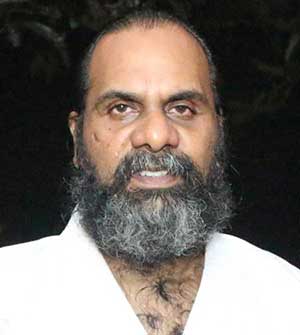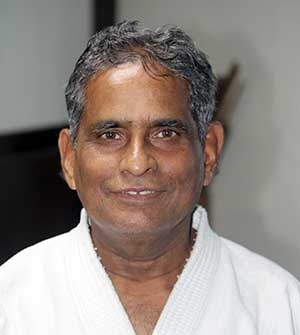
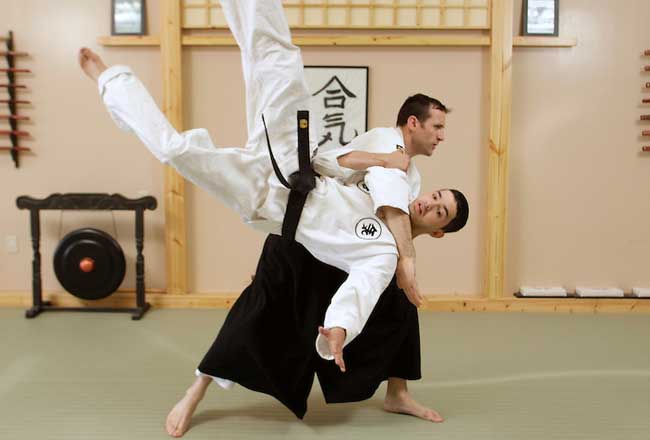
Rs.3000/month
Classes on : Saturday, Sunday
- Style
- Aikikai
- Affiliated To
- Aikikai Foundation (founded by O' Sensei Morihei Ueshiba )
- Study Mode
-
- Offline & Online : Aikido Basics and advanced techniques
Aikido Founder, Morihei Ueshiba
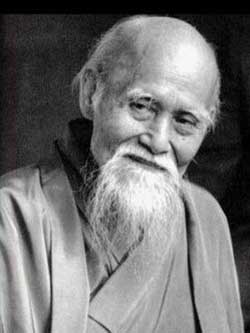 'Defence with a smile' is one of the beautiful definitions given to the system of Aikido, a traditional Japanese martial art, was developed in the early part of the 20th century by Morihei Ueshiba (1883-1969), known as O-Sensei (venerable teacher). O-Sensei, was born in 1883 in Tanabe, a coastal town in southern Japan. From the time of his youth, he studied various martial arts, eventually including Sumo, Swordsmanship, Spear technique, Staff technique, and various styles of Jiu Jitsu, particularly the Yagyu and Daito styles.
'Defence with a smile' is one of the beautiful definitions given to the system of Aikido, a traditional Japanese martial art, was developed in the early part of the 20th century by Morihei Ueshiba (1883-1969), known as O-Sensei (venerable teacher). O-Sensei, was born in 1883 in Tanabe, a coastal town in southern Japan. From the time of his youth, he studied various martial arts, eventually including Sumo, Swordsmanship, Spear technique, Staff technique, and various styles of Jiu Jitsu, particularly the Yagyu and Daito styles.
Philosophy
Literally, Aikido translates as "the way of harmony with Ki." Aikido seeks to unite this Ki of the Universe with the Ki found within each person. The Founder of Aikido believed that a person was at their highest level of self-actualization when univeral ki and one’s personal ki were aligned. Use of the word “ki” or spirit in a Japanese context doesn’t necessarily imply that of a religious connotation. Rather, it recognizes the inherent energy found in all living and non-living things… all matter and non-matter, that is.
Purpose of Aikido
The purpose of Aikido training is the perfection of a martial skill, attitude and the improvement of one's character. The objective of Aikido is invariably to defend yourself against an attack, but not to brutally hurt attackers, rather control incoming forces and subdue the attacker. Ultimately the system of Aikido is to contribute to the making of a better society through the united training of body, mind and spirit. O-Sensei, the founder of Aikido, spent decades spreading this message of peace through the art of Aikido.
Our Aikido School
Our Aikido school has been affiliated to Aikikai Fondation, New Delhi. The classes are being supported by Dojo-Cho Sensei Paritos Kar (6th Dan Black Belt), the Chief instructor of this organization.
Sensei Paritos Kar (6th Dan Black Belt)
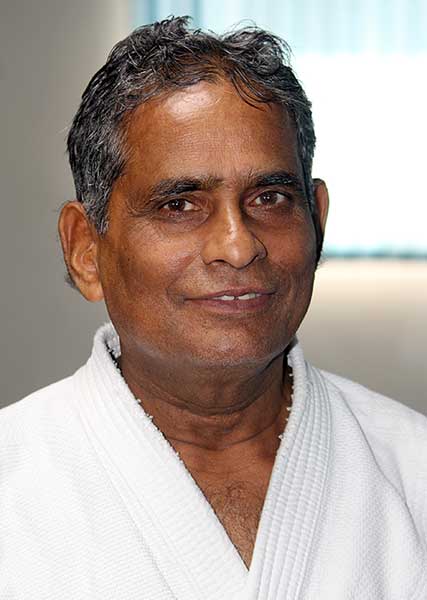 Sensei Paritos Kar was born in the small town of Cooch Behar in West Bengal. A friend introduced him to Aikido, while he was in Japan studying at the Language Institute of Tokyo. In 1987, after studying Japanese for two years, he started his Aikido training. Sensei Kar has over fifteen years of training in Aikido, including five years in a special Aikido Academy.
Sensei Paritos Kar was born in the small town of Cooch Behar in West Bengal. A friend introduced him to Aikido, while he was in Japan studying at the Language Institute of Tokyo. In 1987, after studying Japanese for two years, he started his Aikido training. Sensei Kar has over fifteen years of training in Aikido, including five years in a special Aikido Academy.
Sensei Paritos has trained under many of the senior ranking teachers at the Aikikai Hombu Dojo. He is indebted to teachers like the late Doshu, Kisshomaru Ueshiba; his son, Moriteru Ueshiba Doshu; Okumura Sensei and Yamaguchi Sensei. He is also grateful to the Aikido academy and the teachers at the time: Seki Sensei, Osawa Sensei, Kobayashi Sensei and Kanazawa Sensei.
Why Should I Do The Course?
In today's world, governed by well-established laws, any form of aggressive response—even in self-defense—may be considered an offense unless proven otherwise. Often, the aggressor could be someone close to you, acting out of sudden emotion, intoxication, or other influences, making it difficult to respond with a harmful counterattack. This is where a system like Aikido becomes invaluable, as it focuses on neutralizing threats with minimal harm, making it highly effective for handling everyday conflicts. At the same time, in extreme emergency situations, its techniques can be executed with lethal precision—a unique flexibility that most self-defense systems lack.
